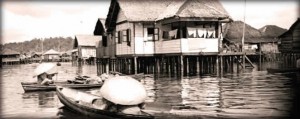What is PADIAN?
Every day, early in the morning, boats called Gubang, Bidar or Perahu could be seen on the Brunei River. These boats were rowed by women wearing wide hats called Siraung. The women would then row from one house to another in Kampong Ayer (Water Village) selling daily necessities such as vegetables, fruits, fish and other daily supplies. Some of them also plied their wares along the jetties near the capital, Bandar Seri Begawan. A Padian was seen as a floating market selling all sorts of foodstuffs, vegetables and commodities.
Padian was a common sight on the Brunei River, so much so, it was mentioned by the famous explorer, Antonio Pigafetta in 1521 AD. According to him, Padian had been in this trade for hundreds of years.
The Padian declined due to a number of factors. By 1906, with the migration of the administration from the water village to dry land, it encouraged residents of Kampong Ayer to migrate to the interior parts. The development of the dry land and the capital brought about the existence of markets and ‘Tamu’ or smaller markets. The Padian failed to continue serving as the centre of trade as those markets on dry land began to develop. However, they have played an important role in the development of Brunei’s economy for the last 500 years. By 1980’s, Padian activities had slowed down significantly. Today, Padian are no longer to be seen, surviving only in memory, paintings and photographs. Yet the history of Padian is the history of Kampong Ayer (Water Village) itself.










